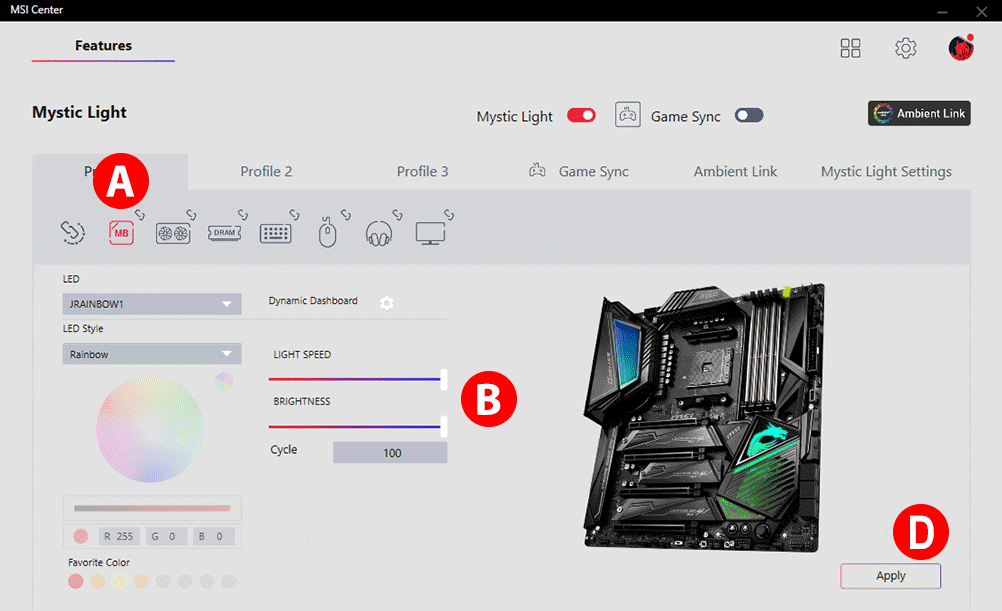For enthusiasts seeking to enhance their PC setups with mesmerizing RGB lighting effects, the MSI Mystic Light ecosystem stands as a prominent option. In this review, we will delve into the hardware connections, software functionalities, and overall performance of MSI Mystic Light, focusing particularly on its compatibility with MSI motherboards.
Please follow us on Twitter and Facebook.
Hardware Connections and Setup for MSI Mystic Light
MSI motherboards typically offer a variety of RGB ports catering to different voltages and connector types. The common ones include the 12-volt JRGB ports and the 5-volt JRAINBOW ports, along with the JCORSAIR port for Corsair-style connectors. The demonstration conducted here utilized the B550 Gaming Plus motherboard, featuring a combination of these ports. Additionally, onboard RGB elements are prevalent in gaming motherboards, albeit varying in complexity. The B550 Gaming Plus showcases a single RGB element on the PCH, controllable seamlessly through MSI Mystic Light.
Utilizing RGB hubs, allows for convenient distribution of RGB signals from the motherboard to multiple RGB components, facilitating diverse lighting configurations.
MSI Mystic Light Installation
To harness the power of MSI Mystic Light, one must first navigate through the MSI Center application and install the Mystic Light extension. Once initiated, MSI Mystic Light unfolds a plethora of features. From global lighting effects to device-specific controls, version 3.0.0.09 of the software offers a comprehensive suite for RGB customization aficionados. Despite a somewhat convoluted installation process, Mystic Light offers a user-friendly interface for controlling RGB lighting.

The Mystic Light software interface provides users with intuitive controls for configuring RGB lighting effects. Divided into different LED zones, users can customize each zone with various lighting styles and colors. Notably, the software allows for synchronization or individual control of RGB components, offering flexibility in lighting setups.
MSI Mystic Light Effects

MSI Mystic Light truly shines when it comes to its collection of effects. With a massive 36 unique options, ranging from classic color waves to dynamic audio-reactive patterns, there’s something for every RGB enthusiast. However, there’s room for improvement in offering finer control over color selection and ensuring smoother transitions between effects.
Voice Control and Additional Features of MSI Mystic Light
MSI Mystic Light boasts voice control functionality, enabling users to command RGB lighting settings through voice prompts. While functional, this feature may present limitations in complex setups.
Ambient Link, a feature intended to synchronize RGB lighting with compatible devices like Nanoleaf and Philips Hue, was unfortunately inaccessible due to compatibility constraints with non-Wi-Fi-enabled motherboards.
Usability and Bugs
While Mystic Light shows off an intuitive interface and commendable device detection prowess, it’s not without its quirks. Limited levels of brightness and speed control, coupled with occasional lag issues, slightly dampen the user experience. Moreover, while bugs are few and far between, discrepancies in effect transitions and compatibility hiccups with third-party devices do warrant attention.
Signal RGB/Open RGB Compatibility
MSI motherboards are also compatible with third-party RGB control software like Signal RGB and Open RGB, providing alternatives for users seeking more advanced RGB customization.
In conclusion, MSI Mystic Light offers a commendable solution for RGB lighting control, particularly for users already invested in MSI motherboards. While the software may lack in-depth customization features and faces compatibility constraints with certain functionalities, it remains a viable option for enthusiasts seeking to elevate their RGB lighting setups. With support for third-party software and a diverse range of compatible devices, Mystic Light presents an accessible avenue for achieving captivating RGB aesthetics in PC builds.





